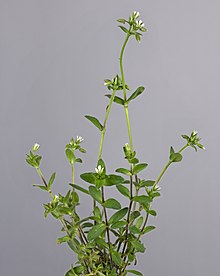Cerastium glomeratum
| Cerastium glomeratum | |
|---|---|

| |
| Scientific classification | |
| Kingdom: | Plantae |
| Clade: | Tracheophytes |
| Clade: | Angiosperms |
| Clade: | Eudicots |
| Order: | Caryophyllales |
| Family: | Caryophyllaceae |
| Genus: | Cerastium |
| Species: | C. glomeratum
|
| Binomial name | |
| Cerastium glomeratum | |
Cerastium glomeratum is a species of flowering plant in the family Caryophyllaceae known by the common names sticky mouse-ear chickweed and clammy chickweed. It is probably native to Eurasia but it is known on most continents as an introduced species. It grows in many types of habitat. The blooming period is February, March, April, and May.[1]
Description
This is an annual herb growing from a slender taproot. It produces a branched, hairy stem up to 40 or 45 centimeters tall. The hairy leaves are up to 2 or 3 centimeters long and are gland-tipped.[2] The inflorescence bears as few as 3 or as many as 50 small flowers clustered with short cymes.[2] The flower has five hairy green sepals which are occasionally red-tipped, and five white two-lobed petals which are a few millimeters long and generally shorter than the sepals. Some flowers lack petals. The fruit is a capsule less than a centimeter long which is tipped with ten tiny teeth.
Habitat
Frequent in waste places,[2] walls, banks and arable land.[3][4]
Uses
The leaves and shoots were used as a wild food in ancient China.[5] In Nepal, the juice of this plant was applied to the forehead to relieve headaches. The juice could also be dropped into the nostrils to treat nosebleeds.[6]
The leaves can also be boiled and eaten.[7]
References
- ^ "Calflora: Cerastium glomeratum". www.calflora.org. Retrieved 2017-05-10.
- ^ a b c Parnell, J. and Curtis, T. 2012 Webb's An Irish Flora. Cork University Press. ISBN 978-185918-4783
- ^ Hackney, P. (editor) 1992. Stewart & Corry's Flora of the North-east of Ireland. Institute of Irish Studies, The Queen's University of Belfast. ISBN 0-85389-446-9
- ^ Clapham, A.R., Tutin, T.G. and Warburg, E.F. 1968. Excursion Flora of the British Isles. Second edition. Cambridge University Press.
- ^ Read. B.E. (1977) Famine Foods of the Chiu-Huang Pen-ts'ao. Southern Materials Centre, Taipei.
- ^ "Cerastium glomeratum sticky chickweed PFAF Plant Database". www.pfaf.org. Retrieved 2017-05-10.
- ^ Niering, William A.; Olmstead, Nancy C. (1985) [1979]. The Audubon Society Field Guide to North American Wildflowers, Eastern Region. Knopf. p. 455. ISBN 0-394-50432-1.
External links
- Jepson Manual Treatment
- USDA Plants Profile
- "Cerastium glomeratum". Germplasm Resources Information Network. Agricultural Research Service, United States Department of Agriculture.
- Flora of North America
- Photo gallery
